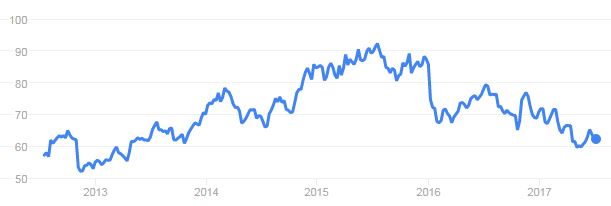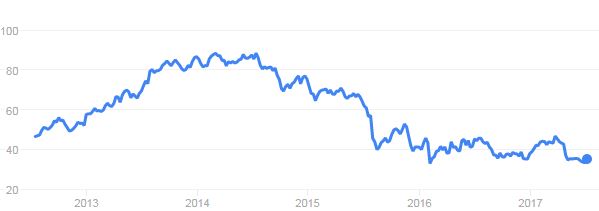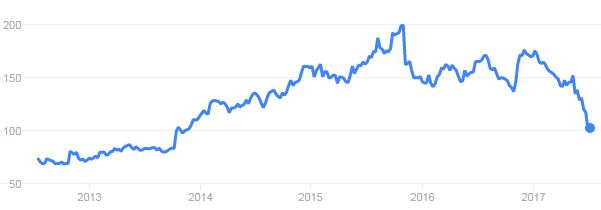Falling Stars Stocks
July 2017
We examine 3 stocks that have previously been high-fliers but have seen significant drop in the stock price.

Express Scripts (ESRX)

- Dividend Yield 0.0%
Express Scripts (ESRX)
Competitive Strengths
Express Scripts (ESRX) is one of the largest pharmacy benefit management organization (PBM), acting on behalf of clients’ to administer members’ drug prescriptions, manage formularies (approved branded and generic drugs) and negotiate discounts from manufacturers.
Top 3 PBMs combined (ESRX together with CVS and UnitedHealth) control 80% of the market. Business model of PBMs is based on extracting value from manufacturers and pharmacies to obtain cheaper medical drug prices for the benefit of the client (employers) and its members (employees), pool and leverage scale to efficiently process large number of claims (ESRX processed 1.4bln claims in 2016 alone) and shift the clients’ members from branded drugs towards cheaper generics (through managing formularies).
In effect, PBMs play a role of chief negotiator with the pharma industry and buyer of medical drugs on behalf of its many thousands of their clients. PBM are able negotiate better discounts that individual client, so the logic goes. Outside US such role is typically played by government or national health service, however in the US the system is private, thus shifting the burden of negotiations to the individual insurance companies and health insurance payers (employers).
PBM get compensated for the administrative processing and fulfillment of the prescriptions (service revenue margin) and increasingly for negotiating sufficiently large discounts to keep portions of the discount (product revenue or resale margin) and for transitioning patients from branded products to generic versions (product substitution margin).
We believe that from the profits’ standpoint in our view, PBMs’ ability shift prescription from branded drug to much cheaper generic version and capturing the difference, effectively exploiting a product substitution or product arbitrage, is an important source of margin. So whilst, PBMs align themselves to clients’ and patients’ interest to use generics and lower-cost brands, at the same time, PBMs do not fully pass on the savings achieved by conversion to its clients. This effectively means that PBMs are creating margin by re-selling generics use as quasi branded product – product arbitrage.
This is possible in the short term because generic drugs by definition achieve the same medical outcome as patented branded drugs. Therefore, we believe that in the short-term such practice is possible. Sooner or later however competitive pressures will ensure that product re-selling margins on generics will be compressed. One can’t forever sell generics and charge as if they were branded drugs.
PBMs also retain estimated 10% of the rebates obtained by the manufacturer for their own account (source Bloomberg article), instead of passing it on to the client and members. Unfortunately, PBMs are not transparent on the source of their margin hence it is difficult to accurately estimate and forecast how margins will evolve. We believe that lack of transparency creates a misalignment of financial interests between PBMs and their clients. Retained rebates are subject to competitive pressures by more transparent PBMs, distributors and/or direct purchases and therefore we do not believe that these margins can be sustained at elevated levels long-term
So the only way to growth product re-sale margin is to continually increase the mix of generics within overall prescription pool. Based on ’16 annual report, ESRX achieved generic fill rate of 85.3% in 2016 compared to 84.4% in 2015 and 82.9% in 2014. At 85.3% generic fill rate, the arbitrage opportunity has reached the plateau. It is unlikely that all prescription will be 100% generic after all. It is also reasonable to assume the margins on generic drugs will revert to low, after initial hiatus when branded drug gets converted to generic drug.
In terms of revenue pool, product sales make up 98% of ESRX revenue and far outweigh services revenue. In our opinion, the competitive advantage for ESRX is narrow at best, and primarily driven by the volume of prescription (services margin) and discounts obtained (product re-sale margin). Branded drug to generic drug (product arbitrage margin) is unlikely source of sustainable competitive advantage in the long-term and may turn into headwind as generics fill rate plateaus.
Valuations
ESRX doesn’t separate its profit pool between services, product resale and product substitution.
Historical cost of goods sold (COGS) over the past 10 years is 90.91%. 2017 COGS was 89.26%. The difference of 1.65% is likely attributable to additional product arbitrage, which translates to additional $1.654bln of gross profit margin with relatively little additional cost. Net profit boost is estimated at $1.07bln (at 35% tax rate).
We model that ESRX 2016 operating income of $5bln, is made up for $0.5bln of services operating income (30% of services revenue of $1.4bln), $2bln of rebates and discounts obtained from manufacturers (guestimate) and $2.3bln of product substitution margin (guestimate).
We propose the following multiples:
| Operating profit segment | (2016) $bln | EBIT Multiple | Valuation ($bln) |
| Services op. profit | 0.7 | 18 | 12.6 |
| Product re-sale margin | 2 | 10 | 20 |
| Product substitution margin | 2.5 | 7 | 17.5 |
| Enterprise Value | 50.1 | ||
| Debt | -11.6 | ||
| Equity valuation | 38.5 | ||
| Share count (mln | 594 | ||
| Equity Per Share ($) | $64.8 per share | ||
| Margin of safety | 30% | ||
| Fat Pitch price | $45 per share |
| Competitive Advantage | Fair Value Estimate | Stock Price | Fat Pitch Price | Market Cap. |
| Narrow | $64.8 | $62.1 | $45.0 | $37bln |
| 52 Wk range | ROE (%) | PE Data 2017 | PE Data 2018 | PE Data 2019 |
| $80.02 - $57.80 | 23.8% | 8.9 | 8.0 | 7.3 |

Viacom (VIAB)

- Dividend Yield 2.3%
Viacom (VIAB)
Competitive Strengths
Viacom stock is hitting 5 year low. Viacom is global media conglomerate offering television programs, motion pictures and other entertainment in more than 180 countries. Company operates through two segments: Media Networks and Filmed Entertainment. Main brands include Paramount Pictures, Paramount Animation, Nickelodeon, MTV and Paramount Television brands.
Viacom has narrow set of brands which exposes it to cord cutting, hard negotiations on affiliate fee pricing and outright cutting of their channels from the cable bundle. Nickelodeon is the most profitable part of the portfolio contributing est. 40% of EBITDA profits. Nickelodeon has leading market share for pre-teenage kids audience. Paramount studio and MTV have arguably underperformed their peers and are facing stiff competition.
Company is saddled with significant debt of $12bln, compared to $1.6bln-$2.0bln of annual profits. Whilst market cap of $14bln is half of what it used to be in ’13 (at over $30bln), enterprise value (EV) which includes debt hovers at $26bln ($14bln market cap + $12bln of debt). Any cash from the sale of Viacom’s businesses would first have to go towards debt repayment before shareholders would benefit.
Revenue of the past 9 years has been largely flat (circa $13bln) and compared to previous 10% annual growth, the company is finding growth hard to find. In our view, Viacom’s previous management has underinvested in the content and brands and therefore further weakened its competitive position in the face of digital disruption (from on-demand providers such as Netflix, Amazon, Hulu) and cord cutting / skinny cable bundles phenomena. Increasingly as other leading media companies consolidate and expand the audience to effectively compete, Viacom is being left behind.
Summer Redstone, aging media billionaire, continues to hold controlling stake. We remain underwhelmed by the stewardship displayed by the previous management that Mr Redstone put in place. Newly appointed management (CEO Bob Bakish) has signaled break with the past with new strategy focused on investing in brands. It remains to be seen whether new management can deliver.
Valuations
The valuation of the company is highly sensitive to it’s ability to maintain revenue and preserve margins through its traditional affiliate revenues. The range of fair estimates varies significantly, from $30 per share in no-growth scenario, to $50 in 3% growth scenario. The volatility is further amplified by significant debt leverage.
Fat pitch price would in this case require at least 30% margin of safety, bringing Fat Pitch price to $21-$35 per share depending on the revenue growth evolution scenario. We’d recommend to hold off to prices below $30 to be on the safe side before taking position.
| Competitive Advantage | Fair Value Estimate | Stock Price | Fat Pitch Price | Market Cap. |
| Narrow | $35-$50 (highly sensitive to revenue evolution) | $34.93 | <$30.0 | $14.3bln |
| 52 Wk range | ROE (%) | PE Data 2017 | PE Data 2018 | PE Data 2019 |
| $46.72 - $32.68 | 31.2% | 9.0 | 8.5 | 8.1 |

Advance Auto Parts (AAP)

- Dividend Yield 0.2%
Advance Auto Parts (AAP)
Competitive Strengths
AAP is a large seller and distributor of auto parts for professionals and DIY customers. Shares have suffered 38% fall in the last 12 mths on the back of lower growth in same store sales, leading to re-rating of stocks for lower-rate of growth. PE ratio moderated from 20s to 14 in ’18.
Auto spare parts continues to be decent business, with large fleet of vehicles on road, in 6-12 year range and continued trend to economize on repairs by sourcing spare parts. Business remain competitive with net margins in 5-6% territory, although gross margin is at 50% mark, highlighting opportunities for further streamlining of general sales and overhead cost with the transition to digital sales channels. AAP has some competitive advantage derived from its large distribution network, scale of inventory availability and online presence. Same could be said of their competitors (AutoZone) though.
Industry is relatively slow-growth, with primary drivers being the auto-fleet size, miles driven and the age of the fleet. Low single digit % year-on-year growth of revenue would be a reasonable estimate. Business generates healthy cash and doesn’t require much cash for re-investment. Capex investments are broadly matching depreciation expense. Single largest item on balance sheet is inventory ($4bln), which is 75% funded by Account Payable ($3bln) i.e. suppliers., and unlikely many other retailers, auto part inventory doesn’t become obsolete fast.
Valuations
Fair price estimate would be between $120-$140 per share. Taking into account low margin nature of the business, competitive landscape, digital transition, conservative margin of safety of 30% would apply. This would bring Fat Pitch price to circa $80-$90 per share range.
Similarly, applying PE multiple of 10 would offer investor 10% earnings yield and additional profit growth of 3% per share, offering total yield of circa 13% p.a. At forward EPS for $8.30 in ’18, $83 per share would be an attractive entry point.
| Competitive Advantage | Fair Value Estimate | Stock Price | Fat Pitch Price | Market Cap. |
| Narrow | $130.0 | $102.04 | $83.0 | $7.6bln |
| 52 Wk range | ROE (%) | PE Data 2017 | PE Data 2018 | PE Data 2019 |
| $177.83 - $99.13 | 23.8% | 14.8 | 13.1 | 10.8 |

